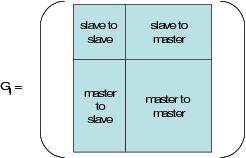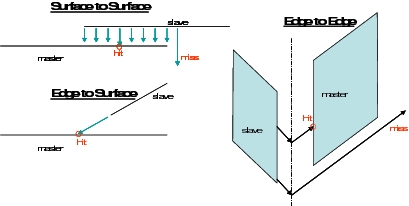XXXXXXXXXXXXXXXXXXXXXXXXXXXXXXXXXXXXXXXXXXXXXXXXXXXXXXXXXXXXXXXXXXXXXXXXXXXXXXXXXXXXXXXXXXXXXXXXXXXXXXXXXXXXXXXXXXXXXXXXXXXXXXXXXXXXXXXXXXXXXXXXXXXXXXXX''"> Surface to Surface (S2S) Method
S2S is a more sophisticated method used to connect two surface meshes, which need not be congruent. The S2S method can be used to connect 2D surface to 2D surface, 1D edge to 2D surface, or 1D edge to 1D edge, and makes use of the application region designations as master and slave. The S2S method in SDB2SG uses sophisticated numerical integration techniques expanded from and inspired by D. Trujillo and C. Pappoff of Boeing Satellite Systems in their paper entitled “A General Thermal Contact Resistance Finite Element”. Their surface-to-surface method was extended to include edge-to-edge and edge-to-surface cases as well as optimized for efficient execution.
The following requirements apply to using this method
• The slave surface mesh is comparable to or finer than the master surface mesh.
• For edge-to-surface contact, the edge must be the slave and the surface must be the master.
S2S works by mapping the slave surface area to the master surface mesh. The element faces on the slave surface are divided into sub-areas for integration. Projecting a sub-area point to the master surface determines which master element face is aligned with this integration point. Thus each integration point can be viewed as connecting a piece of the slave element face to the master element. Now this area must be divided and allocated to the nodes associated with the element faces at each end of this integration projection, which is accomplished using the element shape functions. The following equation gives the

contribution to coupling nodes
i and
j, where

is the contact coefficient, and

and

are the shape functions associated with nodes
i and
j, and A is the sub-area for this integration point.
(10‑1)

This calculation is carried out for every possible i-j node pair combination for each integration point, though a node is not self-connected. This means both interface node couplings and intra-face nodal coupling are created. Equation
(10‑1) is integrated over all slave element faces to construct the overall contact element matrix, which in turn is summed over all the element faces. This process is described in Eq.
(10‑2). The summation is carried out over the slave element faces, and the integral is carried out over each slave face using Gaussian Quadrature.
(10‑2)

As SDB2SG carries out the calculations in Eq.
(10‑2), each integration step is checked during projection to the master surface. Unless a master element face is intersected, the integration sub-area does not get included in the interface. Therefore, this method self-corrects for the case when the slave surface overhangs the master surface boundary, automatically finding the correct common interfacial area. For radiation across closely spaced parallel surface, Eq.
(10‑2) is modified as follows:
(10‑3)

Upon completion of these calculations, the resulting contact matrix is square and symmetrical and contains M rows and M columns, where M = the total number of nodes on both the master and slave surfaces. Organizing the matrix according to nodal master/slave associations produces the block-symmetric matrix shown schematically in the following figure. Intra-face and inter-face connections have opposite signs. In SINDAG, inter-face conductors are positive, intra-face conductors negative. The positive conductors add up to the correct area multiplied by the contact coefficient. It should be noted that the upper-right/lower-left blocks of the matrix define the Constraint Matrix. In the future, such matrices will be used to model perfect contact surfaces, and may also be employed in automatic model reduction schemes.

The S2S method differs in how it projects integration points depending on the geometry of the receiving master surface. Direct normal projection is used between surfaces. For edge to surface contact, the projection direction is parallel to the slave element face, but normal to the edge. Either method computes the strike point on the master element face. For edge to edge projection, a direct strike is not required, because the master/target edge is so small that round-off error could cause false misses. Instead, these intersections are computed with the point of closest perpendicular approach. In effect, the plane of intersection is used instead of the point of intersection. The following figure clarifies this idea.
Ultimately, each contact becomes a set of conductors in the SINDAG input file with negative values for intra-face conductors, and more intuitive positive values for the inter-face conductors. For non-congruent interfacing meshes, the negative conductors are essential for accuracy. Without these negative conductors, the inter-face couplings contribute to heat transfer in directions both parallel and perpendicular to the surfaces. The negative conductors effectively cancel these erroneous parallel conductance contributions.
Though this MSC Sinda for Patran feature handles contact heat transfer robustly for a large variety of situations, its true benefit is seen when modeling more complex assemblies. Traditionally, significant modeling time was required to create congruent mesh alignments across contacting interfaces. This time-consuming process can now be eliminated in virtually all practical cases, though maintaining congruent interfaces may remain the best option for accuracy-critical applications.

